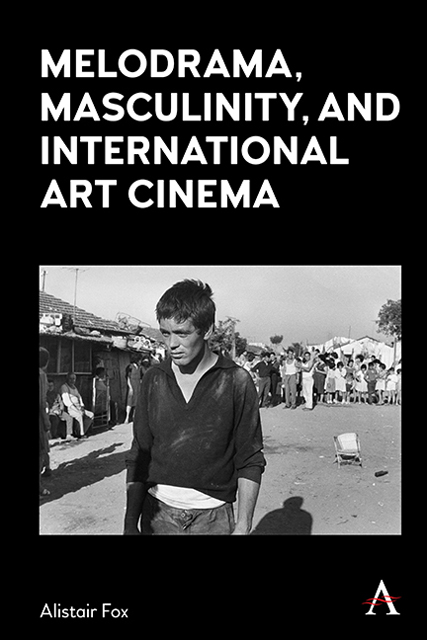Book contents
- Frontmatter
- Dedication
- Contents
- List of Figures
- Preface
- Acknowledgments
- Introduction
- Chapter 1 Italian Neorealism and the Emergence of the Male Melodrama: Vittorio De Sica’s Bicycle Thieves (1948) and Umberto D. (1952)
- Chapter 2 The Migration of Male Melodrama into Non-Western Cultures: Satyajit Ray’s The Apu Trilogy (1955–59) and “Fourth Cinema”
- Chapter 3 Hollywood Melodrama as a Vehicle for Self-Projection: Vincente Minnelli’s Tea and Sympathy (1956) and Home from the Hill (1960)
- Chapter 4 The Political Turns Personal: Neo-Neorealism and Pier Paolo Pasolini’s Accattone (1961)
- Chapter 5 Personal Cinema as Psychodrama: Ingmar Bergman’s Wild Strawberries (1957), Winter Light (1963) and Hour of the Wolf (1968)
- Chapter 6 François Truffaut and the Tyranny of Romantic Obsession: The Soft Skin (1964), Mississippi Mermaid (1969) and The Woman Next Door (1981)
- Chapter 7 Figuring an Authorial Fantasmatic: Jacques Demy’s The Umbrellas of Cherbourg (1964), A Room In Town (1982) and Parking (1985)
- Chapter 8 Rainer Werner Fassbinder and the Emergence of Queer Cinema: The Merchant of Four Seasons (1972), Fox and His Friends (1975) and In a Year with 13 Moons (1978)
- Chapter 9 Visual Aestheticism and the Queer Prestige Melodrama: Call Me by Your Name (2017) and Luca Guadagnino’s Desire Trilogy
- Conclusion
- List of Films Cited
- Select Bibliography
- Index
Chapter 9 - Visual Aestheticism and the Queer Prestige Melodrama: Call Me by Your Name (2017) and Luca Guadagnino’s Desire Trilogy
Published online by Cambridge University Press: 10 January 2023
- Frontmatter
- Dedication
- Contents
- List of Figures
- Preface
- Acknowledgments
- Introduction
- Chapter 1 Italian Neorealism and the Emergence of the Male Melodrama: Vittorio De Sica’s Bicycle Thieves (1948) and Umberto D. (1952)
- Chapter 2 The Migration of Male Melodrama into Non-Western Cultures: Satyajit Ray’s The Apu Trilogy (1955–59) and “Fourth Cinema”
- Chapter 3 Hollywood Melodrama as a Vehicle for Self-Projection: Vincente Minnelli’s Tea and Sympathy (1956) and Home from the Hill (1960)
- Chapter 4 The Political Turns Personal: Neo-Neorealism and Pier Paolo Pasolini’s Accattone (1961)
- Chapter 5 Personal Cinema as Psychodrama: Ingmar Bergman’s Wild Strawberries (1957), Winter Light (1963) and Hour of the Wolf (1968)
- Chapter 6 François Truffaut and the Tyranny of Romantic Obsession: The Soft Skin (1964), Mississippi Mermaid (1969) and The Woman Next Door (1981)
- Chapter 7 Figuring an Authorial Fantasmatic: Jacques Demy’s The Umbrellas of Cherbourg (1964), A Room In Town (1982) and Parking (1985)
- Chapter 8 Rainer Werner Fassbinder and the Emergence of Queer Cinema: The Merchant of Four Seasons (1972), Fox and His Friends (1975) and In a Year with 13 Moons (1978)
- Chapter 9 Visual Aestheticism and the Queer Prestige Melodrama: Call Me by Your Name (2017) and Luca Guadagnino’s Desire Trilogy
- Conclusion
- List of Films Cited
- Select Bibliography
- Index
Summary
There remains one important strand in the evolution of the male melodrama that has influenced the work of twenty-first-century filmmakers: what I shall call “the baroque Italianate art film.” This style of film is characterized by a self-consciously heightened aestheticism that reflects its close relationship with high culture, including, for example, Italian opera, Renaissance painting, and the world of fashion. It is manifest in ornate décor, opulent color effects, extensive use of chiaroscuro lighting effects, and a “musical” use of the camera that artfully composes long shots, close-ups, tracking shots and, on occasion, unusual camera angles in a pleasing rhythm. The baroque Italianate art film is imbued with a sensibility that filmmakers have found lends itself to the presentation of homoerotic themes.
Among the earlier post–World War II progenitors of this style, two stand out: Luchino Visconti and Bernardo Bertolucci. Visconti’s Death in Venice (Morte a Venezia, 1971) shows all the hallmarks of this style: a nostalgic preoccupation with beauty—on the part of the protagonist, Aschenbach (Dirk Bogarde), who becomes obsessed with the beauty of a Polish youth—conveyed through an opulent mise-en-scène that supports a plot laden with romantic pathos intensified by a musical score drawn mainly from Gustav Mahler’s Third and Fifth Symphonies. With Bertolucci, the style is most spectacularly displayed in The Conformist (Il conformista, 1970) in the form of expressionistic lighting effects, rich colors, a fluid camera and strikingly composed architectural shots. Both Visconti and Bertolucci reflect the influence of Italian opera, not least in the inclusion of staged performances from Verdi’s operas: Visconti’s Senso (1954), for example, opens with a performance of Il Trovatore, while Bertolucci’s characters in Before the Revolution (Prima della rivoluzione, 1964) attend a performance of Macbeth, while those in Luna (La Luna, 1979) watch a rehearsal of Un Ballo in Maschera.
This baroque aesthetic has recently resurfaced in the films of contemporary filmmakers focusing on masculine emotional experience. One notable example is The Great Beauty (La grande bellezza, Paolo Sorrentino, 2013), which represents the search for beauty of a 65-year-old journalist to offset the superficiality of the high life he has led during his career in Rome.
- Type
- Chapter
- Information
- Melodrama, Masculinity and International Art Cinema , pp. 177 - 196Publisher: Anthem PressPrint publication year: 2022

